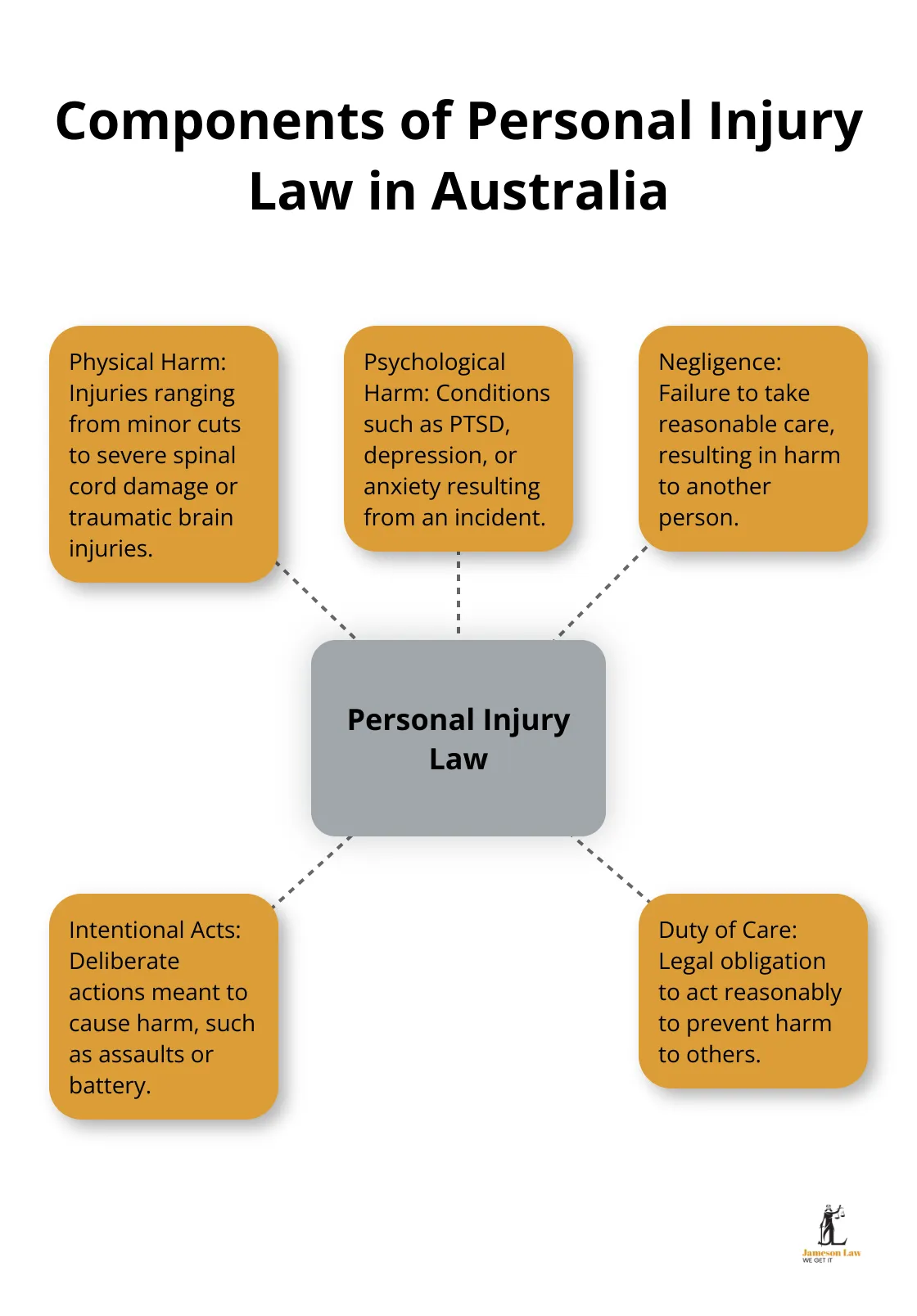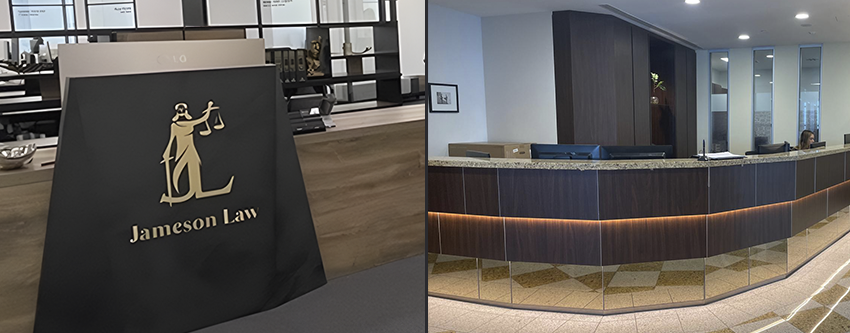Personal injury cases can be complex and confusing for those unfamiliar with the legal system. Understanding the personal injury legal definition is crucial for anyone who’s been hurt due to someone else’s actions or negligence.
At Jameson Law, we’ve seen firsthand how these cases can impact lives. This post will break down the legal definition of personal injury in Australia and explain the different types of claims you might encounter.
What Is Personal Injury in Australian Law?
Physical Injuries: Beyond Broken Bones
In Australian law, personal injury encompasses physical or psychological harm caused by another party’s negligence or intentional actions. This legal concept covers a wide range of situations, from car accidents to workplace incidents.
Physical injuries often represent the most visible type of personal injury. These injuries span from minor cuts and bruises to severe spinal cord damage or traumatic brain injuries. According to Safe Work Australia’s Australian Workers’ Compensation Statistics 2020–21 report, labourers accounted for 26% of serious claims in 2020-2021, which underscores the prevalence of physical injuries in just one area of personal injury law.

Psychological Injuries: The Unseen Wounds
Psychological injuries hold equal importance in personal injury law. These injuries include conditions such as post-traumatic stress disorder (PTSD), depression, or anxiety resulting from an incident. The most up-to-date literature estimates that around one in 10 emergency workers are currently suffering from PTSD, although rates are likely to be even higher.
Negligence: The Foundation of Most Claims
Most personal injury claims in Australia rest on the concept of negligence. Negligence occurs when someone fails to take reasonable care, which results in harm to another person. For example, a driver who runs a red light and causes an accident could face a negligence claim.
Intentional Acts: Less Common but Equally Valid
While less frequent, intentional acts also fall under personal injury law. These acts include assaults, battery, or other deliberate actions meant to cause harm. In 2017, the majority of Indigenous assault victims recorded by police were victims of family violence, ranging from 64% (2,700) in New South Wales to 74%, which demonstrates the unfortunate frequency of intentional personal injuries.
The Importance of Legal Expertise
Personal injury cases require a nuanced understanding of Australian law. Each case presents unique challenges and requires a tailored approach to ensure the best outcome for the injured party. Experienced legal professionals possess the knowledge and skills to navigate these complex cases effectively.
As we move forward, we’ll explore the various types of personal injury claims in New South Wales, providing a more detailed look at how these legal concepts apply in specific situations.
Common Personal Injury Claims in NSW
Personal injury claims in New South Wales encompass a wide range of incidents. This chapter will explore the most frequent types of claims to help you identify when you might have a valid case.
Motor Vehicle Accidents
Car crashes top the list of personal injury claims in NSW. Transport for NSW reported 15,364 road crashes resulting in injury in 2022. These accidents often cause whiplash, broken bones, and sometimes more severe injuries (such as spinal cord damage or traumatic brain injuries).
If you’re in a car accident:
- Seek immediate medical attention
- Report the accident to the police
- Collect contact and insurance information from all parties
- Take photos of the accident scene and visible injuries
- Preserve all medical records and receipts
Workplace Injuries
Workplace accidents form another significant category of personal injury claims. Worker fatalities due to injuries sustained in the course of work-related activities reached 183 in 2019. These injuries range from minor strains to severe accidents that result in permanent disability or death.
After a workplace injury:
- Report the incident to your employer immediately
- Seek medical treatment and maintain all documentation
- File a workers’ compensation claim
- Consider legal advice, especially for serious injuries
Slip and Fall Accidents
Slip and fall accidents can occur anywhere – shopping centres, footpaths, or private homes. These incidents often result in fractures, head injuries, or back problems. The Australian Institute of Health and Welfare found that falls accounted for 42% of all hospitalised injuries in 2017-18.
To build a strong slip and fall claim:
- Photograph the hazard that caused your fall
- Obtain contact information from witnesses
- Report the incident to the property owner or manager
- Maintain all medical records and receipts for related expenses
Medical Negligence
Medical negligence claims arise when health care professionals fail to provide an acceptable standard of care. These cases often require expert testimony due to their complexity.
If you suspect medical negligence:
- Request copies of all your medical records
- Obtain a second medical opinion
- Document all symptoms and complications
- Consult with a lawyer experienced in medical negligence cases
Product Liability
Product liability claims involve injuries caused by defective or dangerous products (from faulty appliances to contaminated food). the Australian Competition and Consumer Commission conducts hundreds of recalls each year due to safety concerns.
For a product liability claim:
- Preserve the product and all packaging
- Document how you used the product
- Keep receipts and proof of purchase
- Report the incident to the manufacturer and the ACCC
- Seek medical attention for any injuries
Understanding these common types of personal injury claims can help you navigate the legal process more effectively. However, each case presents unique challenges and complexities. In the next chapter, we’ll examine how to prove a personal injury claim, a critical step in securing the compensation you deserve.
How to Prove Your Personal Injury Claim
Establishing Duty of Care
The first step to prove your personal injury claim requires you to show that the other party owed you a duty of care. This legal obligation compels individuals to act reasonably to prevent harm to others. Drivers must exercise care for other road users, and property owners must maintain safe premises for visitors.
To establish duty of care, you should collect evidence that demonstrates your relationship with the other party. This evidence may include:
- Witness statements describing the incident
- CCTV footage of the accident scene
- Photographs of hazardous conditions
- Documentation of your presence at the location (e.g., receipts, appointment records)
Demonstrating Breach of Duty
After you establish duty of care, you must prove that the other party breached this duty through Their actions or inactions. This involves showing that They failed to meet the expected standard of care.
To demonstrate a breach of duty:
- Collect expert opinions on industry standards
- Obtain police reports or incident reports
- Gather maintenance records for property-related incidents
- Secure statements from witnesses about the other party’s behaviour
In Australia, falls are the leading cause of hospitalised injury (41 per cent) and injury-related deaths (37 per cent of all deaths). Many of these cases likely involved breaches of duty (such as failure to maintain safe public spaces).
Proving Causation
The next critical step requires you to show that the breach of duty directly caused your injuries. This can present challenges, especially in cases with pre-existing conditions or multiple contributing factors.
To prove causation:
- Obtain detailed medical reports linking your injuries to the incident
- Collect before-and-after evidence of your condition
- Secure expert testimony on the likely cause of your injuries
- Document the progression of your symptoms following the incident
Calculating Damages
The final component of proving Your personal injury claim involves calculating the damages You’ve suffered. This includes both economic and non-economic losses.
To accurately calculate damages:
- Keep all medical bills and receipts
- Document lost wages and future earning capacity
- Track expenses related to Your injury (e.g., home modifications, travel costs)
- Maintain a diary detailing pain levels and impact on daily life
According to the latest figures from the Australian Bureau of Statistics, the average full-time wage is now just over $90,000 per year ($1,737.10 per week). This figure can help you calculate lost income claims.
Personal injury claims often involve complex legal processes, and the burden of proof falls on the claimant. Professional legal advice can significantly improve your chances of building a strong case and securing fair compensation for Your injuries.

Final Thoughts
Personal injury law in Australia covers a broad spectrum of physical and psychological harm caused by negligence or intentional acts. The personal injury legal definition encompasses various scenarios, from motor vehicle accidents to workplace injuries, where individuals may seek compensation for their suffering. Proving a claim requires establishing duty of care, demonstrating a breach, showing causation, and accurately calculating damages.

At Jameson Law, we specialise in navigating the complexities of personal injury cases. Our team of experienced lawyers helps clients understand their rights and pursue fair compensation. We offer a No Win No Fee policy for plaintiff personal injury claims, which makes legal representation accessible to those who need it most.
Professional legal guidance can significantly impact the outcome of Your case, ensuring Your rights receive protection and You obtain the compensation you deserve. If you face challenges related to a personal injury, focus on Your recovery and allow experienced legal professionals to handle the complexities of Your claim. With the right support, you can navigate the personal injury legal landscape with confidence.













